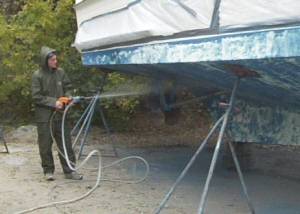 There are several techniques for removing bottom paint, but the one we have chosen here a the yard is water/sand blasting. The water keeps the paint and sand dust from contaminating the yard and makes for easier clean up. With any abrasive removals, the more aggressive you are, the more damage you will do to the gel coat. If we are totally removing the paint, we generally apply a bottom barrier coat to fill any pin holes, visible and invisible, created by the sand blasting. It is never a bad idea to have a barrier coat.
The Maryland Clean Marine has a tip sheet available on choosing bottom paints which you may download here. It also addresses issues such as choosing enviromentally safe products.
There are several techniques for removing bottom paint, but the one we have chosen here a the yard is water/sand blasting. The water keeps the paint and sand dust from contaminating the yard and makes for easier clean up. With any abrasive removals, the more aggressive you are, the more damage you will do to the gel coat. If we are totally removing the paint, we generally apply a bottom barrier coat to fill any pin holes, visible and invisible, created by the sand blasting. It is never a bad idea to have a barrier coat.
The Maryland Clean Marine has a tip sheet available on choosing bottom paints which you may download here. It also addresses issues such as choosing enviromentally safe products. Selecting a bottom paint
One of the most frequently asked questions we get here at the marina is which is the right bottom paint to use. It is also one of the hardest to answer because the proper material to use depends on how you use your boat, where you keep your boat and what you expect to get out of your bottom paint. Such issues as do you frequently have your boat scrubbed by a diver, do you store your boat out of water for long periods and do you keep your boat in an area where marine growth is heavy all come into play when choosing a bottom paint.
Also, if build up of older paint is present on your boat, you should consider removing it and starting fresh. Old build up will eventually lose it’s grip and fall off, taking the newer paint with it. Plus, where the old paint has flaked off and recoated, your bottom starts getting a “less than flat” surface which creates a drag in the water. Also considering the weight of a can of bottom paint, every time you add another coat of paint the weight of your boat increases accordingly, creating fuel inefficiency. While this may not be an issue with slower boats, sometimes the extra speed is desirable.
 There are several techniques for removing bottom paint, but the one we have chosen here a the yard is water/sand blasting. The water keeps the paint and sand dust from contaminating the yard and makes for easier clean up. With any abrasive removals, the more aggressive you are, the more damage you will do to the gel coat. If we are totally removing the paint, we generally apply a bottom barrier coat to fill any pin holes, visible and invisible, created by the sand blasting. It is never a bad idea to have a barrier coat.
The Maryland Clean Marine has a tip sheet available on choosing bottom paints which you may download here. It also addresses issues such as choosing enviromentally safe products.
There are several techniques for removing bottom paint, but the one we have chosen here a the yard is water/sand blasting. The water keeps the paint and sand dust from contaminating the yard and makes for easier clean up. With any abrasive removals, the more aggressive you are, the more damage you will do to the gel coat. If we are totally removing the paint, we generally apply a bottom barrier coat to fill any pin holes, visible and invisible, created by the sand blasting. It is never a bad idea to have a barrier coat.
The Maryland Clean Marine has a tip sheet available on choosing bottom paints which you may download here. It also addresses issues such as choosing enviromentally safe products.
 There are several techniques for removing bottom paint, but the one we have chosen here a the yard is water/sand blasting. The water keeps the paint and sand dust from contaminating the yard and makes for easier clean up. With any abrasive removals, the more aggressive you are, the more damage you will do to the gel coat. If we are totally removing the paint, we generally apply a bottom barrier coat to fill any pin holes, visible and invisible, created by the sand blasting. It is never a bad idea to have a barrier coat.
The Maryland Clean Marine has a tip sheet available on choosing bottom paints which you may download here. It also addresses issues such as choosing enviromentally safe products.
There are several techniques for removing bottom paint, but the one we have chosen here a the yard is water/sand blasting. The water keeps the paint and sand dust from contaminating the yard and makes for easier clean up. With any abrasive removals, the more aggressive you are, the more damage you will do to the gel coat. If we are totally removing the paint, we generally apply a bottom barrier coat to fill any pin holes, visible and invisible, created by the sand blasting. It is never a bad idea to have a barrier coat.
The Maryland Clean Marine has a tip sheet available on choosing bottom paints which you may download here. It also addresses issues such as choosing enviromentally safe products. 
